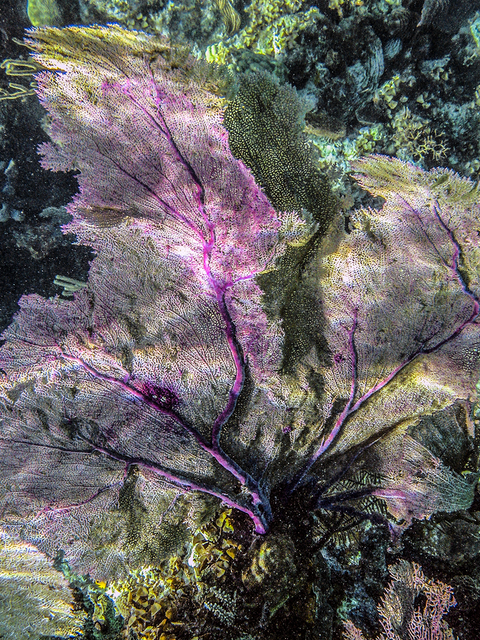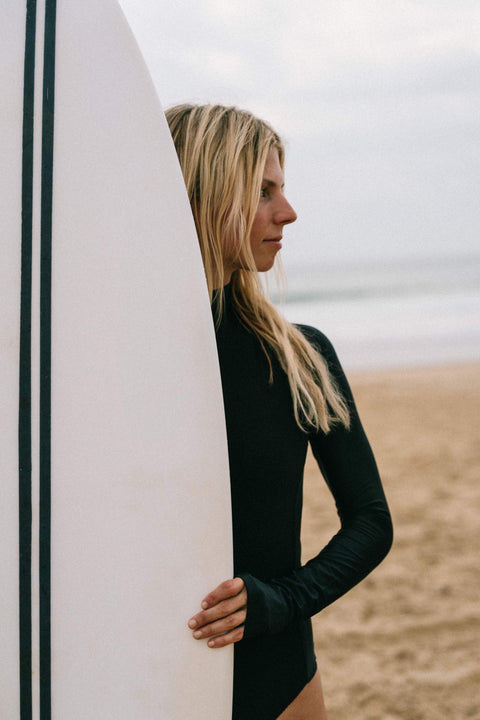
Beneath the Surface: How Sunscreen Choices Affect Coral Reefs
Every year, surfers unknowingly dump the equivalent of 6,000 cars worth of sunscreen into our oceans.
Scientists estimate roughly 14,000 tons of sunscreen wash into our global waterways each year and evidence shows this has real consequences for ocean life, especially coral reefs.
Finding the best reef safe sun protection for surfing shouldn't mean choosing between your skin and the ocean. This post explains how different sunscreens affect coral reefs and what we can do to safeguard our skin while keeping our coral reefs healthy.

The Science: Chemical vs. Mineral Sunscreens
Before we talk about the impact on the reef, let's break down how sunscreen works. There are two main approaches:
Chemical sunscreens use compounds like oxybenzone, octinoxate, and avobenzone that absorb UV radiation and convert it to heat. These lab-engineered molecules became popular in the 80s because they avoided the chalky white look of earlier formulas.
Mineral sunscreens rely on naturally occurring minerals, zinc oxide and titanium dioxide, that sit on your skin's surface and physically block UV rays. Think of them as tiny shields reflecting sunlight away from your skin.
Both offer crucial protection for surfers spending hours in the sun. The key difference? Chemical filters absorb into skin and undergo reactions to neutralize UV, while minerals stay on the surface and physically deflect light. This difference matters when they wash off into the ocean.

Chemical Sunscreens: The Reef Problem
Research shows several common UV-filtering chemicals are toxic to corals and marine life.
Oxybenzone has emerged as a major culprit. Studies show it accumulates in coral tissues and induces bleaching—the stress response where corals expel their symbiotic algae. Even at incredibly low concentrations (about one drop in 6.5 Olympic-size swimming pools), oxybenzone causes DNA damage, deformities in coral larvae, and death of young polyps.
Octinoxate degrades into benzophenone, a hormone-disrupting compound that stresses corals. Octocrylene and avobenzone are also under scrutiny for similar toxic effects.
Recent research in 2022 revealed why these chemicals are so harmful. Corals metabolize oxybenzone into a substance that becomes toxic in sunlight. The compound that protects humans against UV gets transformed inside the corals into a phototoxin that generates harmful free radicals when hit by UV light. As one researcher put it, oxybenzone "made sunlight toxic for corals."
The damage extends beyond corals. Algae experience reduced growth and photosynthesis. Mussels show reproductive defects. Sea urchins suffer immune system damage. Fish develop hormone disruption. Even dolphins accumulate these chemicals in their tissues.
How big is this problem in real-world conditions? Water at heavily visited reefs typically contains 1-10 micrograms per liter of sunscreen compounds. While these levels are below some high-concentration lab studies, scientists warn that subtle, long-term impacts are harder to rule out. Corals already stressed by climate change could be less resilient when dealing with chronic chemical exposure. Think of it like an immune system: a healthy reef might cope with a little pollution, but an unhealthy one could succumb.
Environmental authorities are taking action. In 2018, Hawaiʻi became the first U.S. state to ban the sale of sunscreens containing oxybenzone and octinoxate. Places like Palau, and parts of the Caribbean have enacted similar bans. When governments are willing to ban a consumer product used by millions, it underscores how seriously they're taking the science.

Mineral Sunscreens: Are They Truly Reef-Safe?
With chemical sunscreens under scrutiny, mineral sunscreens are often promoted as "reef-safe" alternatives. In many ways, they are a better choice for ocean lovers. Mineral sunscreens use zinc oxide or titanium dioxide—ingredients that the FDA recognizes as safe and effective for human use and that aren't known to cause coral bleaching or the kind of DNA damage seen with oxybenzone.
NOAA's 2022 review concluded that mineral-based sunscreens are "considered a better option" for aquatic environments because they have fewer known harmful effects on marine life. If you're surfing over a coral reef, wearing a zinc-based sunblock is far less likely to hurt the coral below.
The Fine Print
However, "reef-safe" doesn't mean "reef-neutral." No sunscreen is completely innocent in the environment. Even natural minerals can have an impact:
- Titanium dioxide nanoparticles can produce hydrogen peroxide in seawater when exposed to sunlight.
- Just one gram of sunscreen containing these nanoparticles can generate significant amounts of hydrogen peroxide in a liter of seawater.
- Zinc oxide nanoparticles might be toxic to some marine species or could accumulate in sediments.
The key is particle size and formulation. Mineral sunscreens made with non-nano zinc or titanium (particles larger than 100 nanometers) are considered safest. Many responsible brands note on the label if their mineral actives are non-nano.
The bottom line: opt for mineral-only sunscreens whenever possible, and look for "reef-safe, oxybenzone-free, octinoxate-free, non-nano." You'll still get the UV protection you need, without delivering a dose of poison to the corals you surf over.

Breaking News: Sunscreen That Helps Reefs
Here's something exciting: reef-safe sunscreen leader, Stream2Sea, recently released their Coral Care sunscreen, the world's first sunscreen that doesn't just avoid harming reefs—it actually helps them. Through collaboration with marine scientists at the University of Derby, they've created a formula containing nutrients used by coral farmers to help coral thrive.
Testing shows Coral Care can boost healthy coral growth by up to 21% in some species. The product carries a new "RPF" (Reef Protection Factor) certification that could become the gold standard for marine-safe sunscreens.
It’s currently only available in SPF30, but the concept represents a fascinating shift from "do no harm" to "do good" in sunscreen formulation. If these claims hold up under broader testing, we could be looking at a game-changer for ocean-conscious surfers.

What Surfers Need to Know
Protecting coral reefs from sunscreen pollution doesn't mean sacrificing sun protection. Here's how to keep both your skin healthy and the reefs safe:
Cover up with UPF clothing. Long-sleeve rashguards, surf leggings, and hooded tops shield large areas of skin. By reducing exposed skin, you minimize how much sunscreen you need. A quality UPF50+ rashguard blocks 98% of UV rays and never washes off.
Choose non-nano mineral-based sunscreens. Look for zinc oxide or titanium dioxide as active ingredients. Ensure they're oxybenzone-free, octinoxate-free, and non-nano. Apply generously 15 minutes before hitting the water.
Skip spray sunscreens. Much of the spray ends up on sand or in the air rather than on your skin. Those chemicals wash into the ocean with the tide. Stick to creams or lotions for better coverage and less environmental impact.
Educate others. Share what you know with fellow surfers and beachgoers. Most people don't realize their sunscreen could hurt coral. A friendly conversation can spread awareness.

The Best Waterproof Reef Safe Sun-protection for Surfing:
One of the best ways to protect both your skin and the reef is covering up. Rashguards are lightweight, comfortable, and offer UPF50+ protection.
Wearing a long-sleeved, hooded rashguard drastically cuts the amount of sunscreen you need to use while providing reliable sun protection that won't wash off.
At Vampire Surf Club, we've made this approach central to our mission. Our signature hooded rashguards provide UPF50+ coverage so you can enjoy marathon sessions without needing to apply a tonne of sunscreen. Made from ECONYL® regenerated nylon yarn, with a three panel hood protecting your head and neck, and enlarged peak to shade your face, they’re designed to provide surfers with the ultimate reef-safe sun protection that stays on in water, no matter how long you stay out in the line-up.
The Bigger Picture
The challenges facing coral reefs are massive—rising sea temperatures, pollution, overfishing. Sunscreen pollution is just one piece of the puzzle, but through mindful choices we can help to make a difference.
It's encouraging to see awareness growing: more reef-safe options on shelves, more surfers wearing sun protection, and innovations like Stream2Sea's coral-helping sunscreen. We each have the power to choose reef health over convenience.
As surfers, we're on the front lines of ocean conservation. Understanding how sunscreens affect coral reefs allows us to make informed choices, by choosing reef-friendly sunscreens and sustainable gear, we vote with our actions for a future where coral reefs thrive.
A world with healthy reefs means epic waves, and abundant sea life for generations to come. That's a future worth protecting—one sunscreen choice at a time.

Sources: National Ocean Service, Hawaii Department of Land and Natural Resources, Stream2Sea, University of Derby, Archives of Environmental Contamination and Toxicology, Stanford University research, and various marine conservation organizations.
Complete Bibliography
Primary Scientific Sources
1. Vuckovic, D., et al. (2022)
"Sunscreen chemical kills corals—now scientists know why"
Chemical & Engineering News, Science Magazine
https://cen.acs.org/environment/pollution/Sunscreen-chemical-kills-corals-scientists/100/web/2022/05
-
Key finding: Corals metabolize oxybenzone into phototoxic compounds under sunlight
2. Tovar-Sánchez, A., et al. (2013)
"Sunscreen Products as Emerging Pollutants to Coastal Waters"
PLoS ONE 8(6): e65451
https://journals.plos.org/plosone/article?id=10.1371/journal.pone.0065451
-
Key finding: 14,000 tons of sunscreen enters waterways annually
3. Downs, C.A., et al. (2016)
"Toxicopathological Effects of the Sunscreen UV Filter, Oxybenzone"
Archives of Environmental Contamination and Toxicology
-
Key finding: Oxybenzone causes coral bleaching at 62 parts per trillion
4. Sweet, M., et al. (2024)
"Coral Care Sunscreen Testing Results"
University of Derby Aquatic Research Facility
-
Key finding: 21% coral growth boost with nutrient-enhanced sunscreen
Government and Regulatory Sources
5. National Ocean Service (2022)
"Skincare Chemicals and Coral Reefs"
NOAA Ocean Service
https://oceanservice.noaa.gov/news/sunscreen-corals.html
-
Key finding: Mineral sunscreens considered better option for aquatic environments
6. National Park Service (2022)
"Protect Yourself, Protect the Reef"
https://www.nps.gov/puho/learn/nature/protectyourselfprotectthereef.htm
-
Key finding: Hawaii sunscreen ban implementation and guidelines
7. NOAA Coral Reef Conservation Program (2020)
"The effects of ultraviolet filters and sunscreen on corals"
https://www.coris.noaa.gov/activities/effects-ultraviolet-filters-sunscreen-corals/
-
Key finding: Comprehensive bibliography of UV filter impacts





